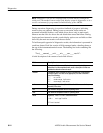
AM700 Audio Measurement Set Service Manual
6–13
Diagnostics
Diagnostics in the AM700 are divided into two sets, low level and high level.
The distinction between the two types is based upon the operating system; those
diagnostics that run before the instrument’s operating system is booted are
referred to as low level; those that run as applications executed by the operating
system are referred to as high level. The instrument pauses noticeably when the
operating system is booting, so messages are displayed indicating when this boot
is occurring to aid the user in differentiating between high- and low-level
diagnostics.
Grouping of diagnostics within the two sets is by circuit board. Within a circuit
board diagnostic are one or more tests; associated with each test is a main
pass/fail result and, where applicable, one or more sub-results. The purpose of
this format is to present all the information used within a test to determine its
ultimate pass/fail status. There is another diagnostic tests grouping, the Overall
Run mode. The three choices are: Power Up mode, Auto Reset mode, and
User-Interactive mode. These are discussed later in this section in Selecting an
Overall Run Mode.
Starting at firmware version 1.02, the normal powerup skips all diagnostics for a
quick start up of operation. Diagnostics can be configured to run automatically
during a normal instrument powerup, or you can access the diagnostics to run at
power on. All the low-level and high-level diagnostics can be forced to run at
power up by holding in the Limits button while turning on the power. Certain
power-up modes can be selected by pressing and holding certain front-panel
buttons during power up (referred to as ‘backdoor boot modes’). For example,
holding the Menu button in while turning on the power causes the AM700 to
enter the low-level diagnostic interface. Another example is that holding one of
the application buttons in while turning on the power starts up the selected
application.
Interactive diagnostics provide the service person choices to control the tests that
run and the manner in which they run. In the user interactive mode, any or all
tests within a group of tests can be selected for execution. From the front panel,
choices are made in the displayed menu by highlighting the choice with the
control knob and then pressing the Select button to actually make a change to the
highlighted selection. The diagnostic menu choices will not respond to presses to
the touch screen.
Diagnostics displays can be routed to one of the instrument serial ports for
viewing on a terminal. This is useful if a malfunction does not permit the testing
progress and results to be displayed on the AM700 CRT. A special setting of the
boot switch is used to route the diagnostic test displays to the serial ports.


















